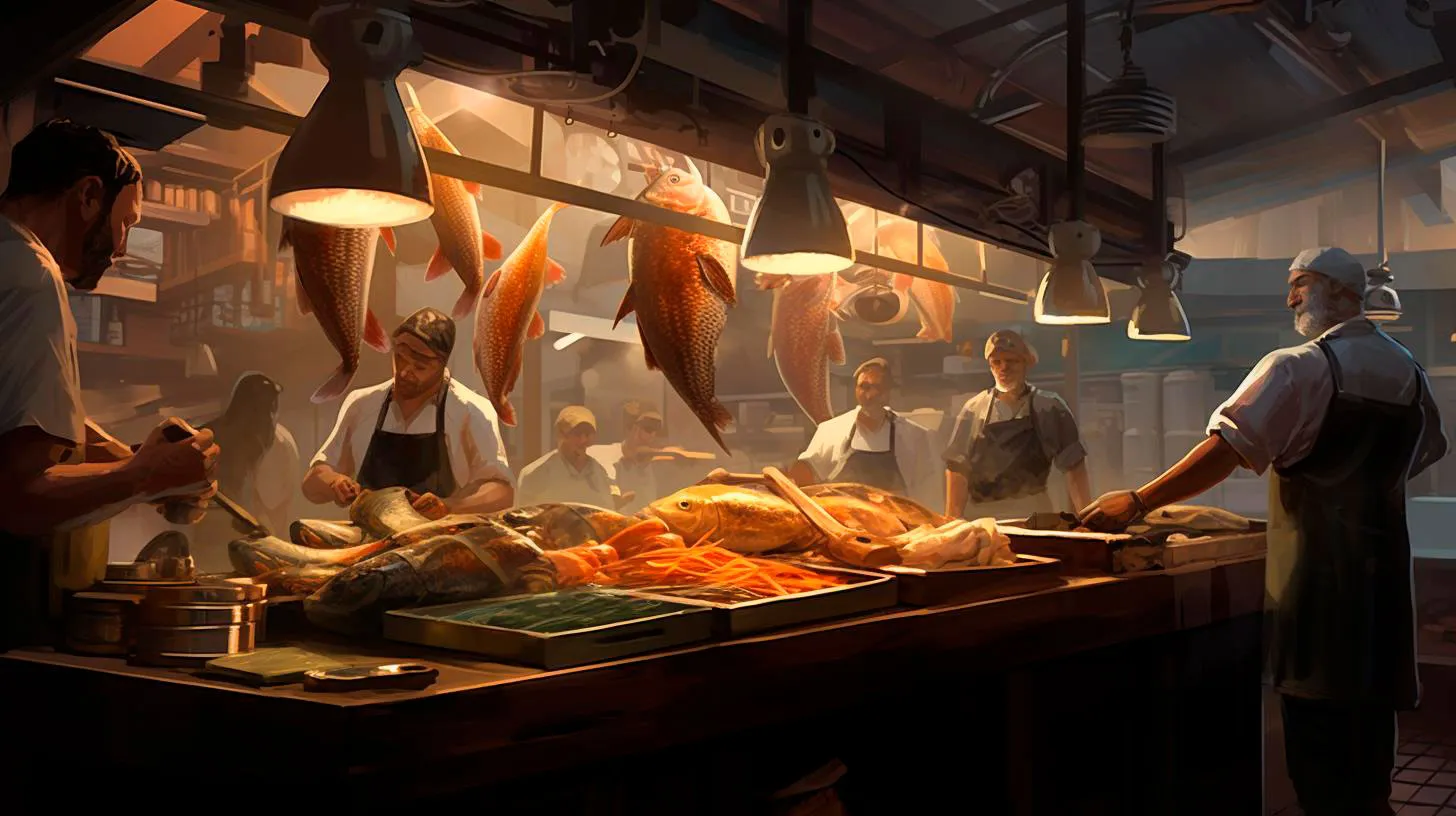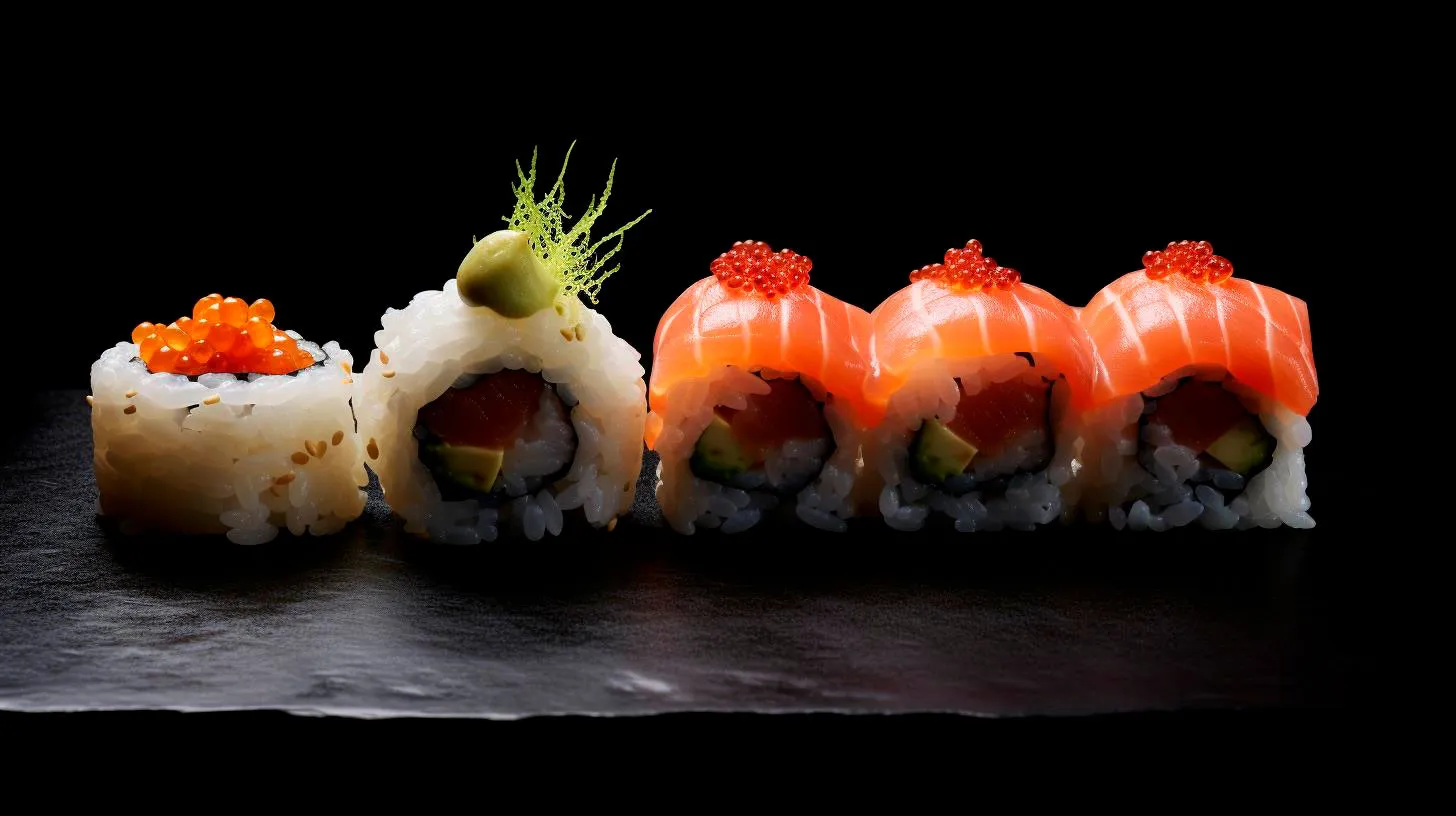The Sushi Chef: Mastering the Art of Japanese Culinary Craftsmanship
In this blog post, we will unravel the skills, responsibilities, and journey of a Sushi Chef, exploring their passion for creating culinary masterpieces that delight our taste buds and leave a lasting impression.
The Skills of a Sushi Chef
Becoming a Sushi Chef requires a unique set of skills that go beyond simply slicing fish and rolling rice. These skilled artisans possess a deep understanding of the ingredients they work with, possess knife skills that are honed to perfection, and have an eye for presentation that transforms each dish into a work of art. Some key skills of a Sushi Chef include:
- Knife Skills: Sushi Chefs spend years perfecting their knife skills, enabling them to make precision cuts and create beautifully arranged sushi plates.
- Understanding of Ingredients: Mastery of sushi requires an understanding of the finest, freshest fish and seafood available, as well as other ingredients like rice, seaweed, and vegetables.
- Palate Development: A Sushi Chef must possess a refined palate, capable of discerning the perfect balance of flavors in each piece of sushi.
- Attention to Detail: Every step of the sushi-making process requires meticulous attention to detail, from the preparation of the rice to the placement of each ingredient on the sushi roll.
- Creativity: While tradition is highly respected, Sushi Chefs also have room to showcase their creativity, experimenting with unique flavor combinations and innovative presentation styles.
Becoming a Sushi Chef
The path to becoming a Sushi Chef is not an easy one. It requires years of dedication, apprenticeship, and a deep passion for the art form. Here are some key steps involved in the journey of becoming a Sushi Chef:
- Training: Aspiring Sushi Chefs often start their journey by undergoing formal training at culinary schools or by joining apprenticeships at renowned sushi restaurants. This hands-on experience allows them to learn the fundamentals and master the techniques under the guidance of seasoned chefs.
- Apprenticeship: Apprenticeships are a critical part of a Sushi Chef’s training. These apprenticeships can last for several years, during which time they work closely with experienced chefs to learn the intricacies of sushi-making, from knife skills to flavor combinations.
- Continuous Learning: Even after completing formal training and apprenticeships, Sushi Chefs never stop learning. They stay up-to-date with the latest trends in both traditional and modern sushi techniques, attend workshops, and strive to perfect their craft throughout their careers.
The Role of a Sushi Chef
Once a Sushi Chef has honed their skills and completed their training, they take on various responsibilities in a sushi restaurant. Let’s explore some of their key roles:
- Sushi Preparation: The primary role of a Sushi Chef is to prepare sushi dishes with the utmost precision and care. From rolling maki sushi to crafting nigiri, they ensure each piece is crafted to perfection.
- Menu Development: Sushi Chefs often have a say in menu development, collaborating with restaurant owners to create new and innovative sushi offerings that excite and entice customers.
- Customer Interaction: Sushi Chefs often engage directly with customers at the sushi bar, offering recommendations, answering questions, and igniting the passion for Japanese cuisine.
- Maintaining Quality: They are responsible for maintaining the highest quality standards for the ingredients used in sushi preparation, ensuring freshness and proper storage.
- Cleanliness and Sanitation: Sushi Chefs rigorously follow hygiene and food safety practices to guarantee a clean and safe dining experience for customers.
The Art of Sushi
The artistry of sushi goes far beyond the taste alone. It is a visual spectacle that delights the senses. Sushi Chefs carefully craft each dish, paying attention to color, texture, and arrangement. The key takeaways from the art of sushi are:
- Visual Presentation: Sushi Chefs create visually appealing plates by skillfully arranging sushi rolls, sashimi, and garnishes, showcasing their creativity and attention to detail.
- Minimalist Aesthetic: The simplicity and elegance of sushi reflect the Japanese philosophy of minimalism. Each ingredient is carefully chosen to enhance flavors and balance, without overpowering the overall dish.
- Harmony of Flavors: Balancing flavors is a cornerstone of sushi. Chefs strive to create harmonious combinations of umami, sweetness, saltiness, and acidity, resulting in a memorable dining experience.
In conclusion, a Sushi Chef’s journey is one of dedication, skill, and passion. These culinary artisans bring together tradition, technique, and creativity to craft exquisite sushi dishes. As you savor each bite of sushi, remember the immense talent and hard work that goes into each piece. Visiting a sushi restaurant is not just about enjoying a meal; it is an opportunity to witness the artistry and craftsmanship of the Sushi Chef.
The Sushi Chef: Crafting Culinary Art with Precision
In this article, we delve into the world of the sushi chef, exploring their skills, techniques, and the secrets behind their mouth-watering creations.
The Artistry of Sushi Making
Sushi has a rich history that dates back to ancient Japan when it was first developed as a means of preserving fish. Over the centuries, sushi evolved from a simple preservation method to an exquisite culinary art form appreciated worldwide. Behind every exquisite sushi platter, there is a skilled sushi chef meticulously crafting each piece with focused precision.
The sushi chef’s role extends beyond preparing raw fish and rice. They are responsible for selecting the finest ingredients, understanding flavor profiles, and mastering knife skills. Each step is executed with meticulous attention to detail and a deep understanding of the art behind sushi making.
The Skills of a Sushi Chef
- Precision Knife Skills: A sushi chef spends years honing their knife skills to perfection. With surgical precision, they slice fish and other ingredients to the desired thickness and size, ensuring every piece is consistent in presentation.
- Palate Mastery: Sushi chefs must have an exceptional palate to identify the subtlest flavors in ingredients. They master the art of balancing flavors, combining the richness of fish, the acidity of vinegar, the crunchiness of vegetables, and the spiciness of wasabi in perfect harmony.
- Presentation Perfection: One of the defining characteristics of sushi is its stunning presentation. Sushi chefs take great care in arranging each piece on the plate, considering color, texture, and shape to create a visually appealing masterpiece.
- Ingredients Selection: The freshness and quality of ingredients are paramount in sushi making. A sushi chef carefully selects the best fish, vegetables, and rice, ensuring only the finest ingredients are used in their creations.
- Time Management: A sushi chef possesses exceptional time management skills. They coordinate multiple orders, ensuring each guest receives their sushi at the peak of freshness while maintaining an efficient workflow.
The Secrets Behind Exceptional Sushi
While the skills mentioned above are crucial, exceptional sushi also relies on the chef’s creativity, knowledge, and attention to detail. Here are some secrets that set apart the best sushi chefs:
- Shape and Texture: Sushi chefs understand the importance of texture in every bite. They carefully mold the rice, creating a firm base that complements the delicate fish perfectly.
- Temperature Balance: A skilled sushi chef knows the ideal temperature for each fish and adjusts the seasoning and preparation accordingly. From slightly chilled to room temperature, every bite is a sensory experience.
- Seasonal Ingredients: Sushi chefs embrace the concept of “shun” or using ingredients at the height of their natural season. By using fresh, seasonal ingredients, the flavors in sushi become even more vibrant.
- Experience and Tradition: Sushi making is rooted in tradition, and the best sushi chefs honor this legacy. They strive to preserve authentic techniques while incorporating their unique touch to create a memorable dining experience.
The Sushi Chef’s Impact on the Culinary World
The influence of sushi chefs extends far beyond their immediate creations. They have played a significant role in popularizing Japanese cuisine worldwide. The rise of sushi restaurants globally owes much to these talented chefs and their commitment to both tradition and innovation. Today, sushi has become a global gastronomic phenomenon, loved by people from various cultural backgrounds.
The Future of Sushi Chefs
As the demand for sushi continues to grow, sushi chefs are constantly evolving, adapting to new culinary trends and techniques. Technology has also made its way into sushi restaurants, with automated sushi machines and conveyor belts offering a modern twist on traditional sushi presentation.
Despite the changes, the artistry of the sushi chef remains at the heart of this culinary world. The ability to combine culinary precision, creativity, and an understanding of flavors sets sushi chefs apart. Their dedication to perfecting their craft ensures that sushi remains an unparalleled dining experience for years to come.
So, the next time you indulge in a beautifully arranged sushi platter, take a moment to appreciate the skill and dedication of the sushi chef behind the scenes.
Inspirational Travel Experiences
1. Trekking in the Himalayas
The mighty Himalayas offer an unparalleled trekking experience for adventure enthusiasts. Surrounded by majestic peaks and breathtaking landscapes, the Himalayas provide a sense of awe and wonder. Whether you choose to conquer the Everest Base Camp Trek or opt for a less strenuous hike in the Annapurna region, the Himalayas hold the promise of serenity, self-discovery, and breathtaking vistas.
- Key takeaway: Trekking in the Himalayas provides a perfect blend of physical challenges and awe-inspiring natural beauty.
- Advantages:
- – Opportunity to witness the snow-capped peaks up close
- – Immersion in the unique cultures and traditions of the region
- – Chance to push your limits and embrace personal growth
2. Exploring the Ancient Ruins of Machu Picchu
Hidden deep within the Peruvian Andes, Machu Picchu is an ancient city shrouded in mystery. This UNESCO World Heritage Site offers a glimpse into the rich history and architectural wonders of the Inca civilization. The splendor of Machu Picchu, combined with the challenging Inca Trail trek, creates a magical experience that continues to captivate travelers from all around the world.
- Key takeaway: Exploring Machu Picchu is a testament to humankind’s ability to create awe-inspiring structures.
- Advantages:
- – Witnessing the sunrise over the iconic ruins is an unforgettable experience
- – Learning about the intriguing history and culture of the Inca civilization
- – Immersing yourself in the stunning Andean landscapes of Peru
3. Diving in the Great Barrier Reef
An underwater paradise like no other, the Great Barrier Reef in Australia is a must-visit for diving enthusiasts. With its vibrant coral reefs and diverse marine life, this natural wonder offers a truly mesmerizing experience. Dive into the crystal-clear waters and encounter magnificent species like turtles, tropical fish, and even the majestic whale sharks.
- Key takeaway: Diving in the Great Barrier Reef is an opportunity to explore the wonders of the ocean and witness its fragile beauty.
- Advantages:
- – Getting up close with colorful coral formations and exotic marine species
- – Contributing to the conservation and preservation of this fragile ecosystem
- – Experiencing the adrenaline rush of exploring the underwater world
4. Safari Adventure in the Serengeti
Embark on an unforgettable safari adventure in the vast plains of the Serengeti, Tanzania. Witness the awe-inspiring spectacle of the Great Migration, where millions of wildebeest and other herbivores journey across the plains in search of greener pastures. Encounter the “Big Five” – lions, elephants, leopards, buffalos, and rhinos, in their natural habitat, and gain a newfound appreciation for the diversity of wildlife on our planet.
- Key takeaway: Safari adventures in the Serengeti offer an up-close encounter with nature’s majestic creatures and a profound sense of awe.
- Advantages:
- – Witnessing the Great Migration, one of the world’s most incredible wildlife spectacles
- – Exploring the vast savannah landscapes and breathtaking sunsets
- – Supporting conservation efforts to protect endangered species
Conclusion
These inspirational travel experiences serve as a reminder of the immense beauty and diversity our world has to offer. From the snow-capped peaks of the Himalayas to the thriving underwater ecosystems of the Great Barrier Reef, each journey holds unique wonders and life-changing moments. So, pack your bags, embrace adventure, and let these experiences ignite your wanderlust.
The Sushi Chef: Artistry Meets Culinary Excellence
In this article, we will explore the world of the sushi chef, their training, skills, and what makes them truly exceptional.
The Birth of a Sushi Chef
Behind the intricate art of sushi-making lies years of dedicated training. Becoming a sushi chef is a journey that encompasses both culinary skills and a deep understanding of Japanese culture. Here are some key takeaways on the path to becoming a sushi chef:
- Japanese Culinary Tradition: The art of sushi-making has been passed down through generations, with a rich history dating back to the 9th century. Sushi chefs must immerse themselves in this tradition to truly master their craft.
- Skill Acquisition: Sushi chefs apprentice under a master chef, known as an itamae, for an extended period, often ranging from 5 to 10 years. During this time, they learn the intricacies of sushi preparation, knife skills, and the art of flavor pairing.
- Dedicated Practice: Perfecting the art of sushi-making requires countless hours of repetition and practice. Sushi chefs must continuously refine their techniques to achieve the perfect balance of flavors, textures, and presentation.
- Attention to Detail: Sushi chefs approach their craft with an incredible level of precision and attention to detail. From the selection of the finest ingredients to the meticulous arrangement of each piece, every element is carefully considered.
The Skills of a Sushi Chef
A sushi chef’s skill and expertise extend far beyond the cutting board. Here are some noteworthy skills that define a sushi chef:
- Knife Mastery: A sushi chef’s most important tool is their knife. With razor-sharp precision, they skillfully slice through fish, creating delicate, uniform slices that enhance both taste and presentation.
- Ingredient Selection: A deep understanding of seafood and other key ingredients is vital for a sushi chef. They carefully select the freshest and highest-quality ingredients to ensure the flavors are at their peak.
- Flavor Balancing: Achieving the perfect balance of flavors is an art form in itself. Sushi chefs skillfully pair ingredients, using subtle seasoning and condiments to enhance the natural taste and texture of each component.
- Menu Creation: Sushi chefs also possess the creativity to design innovative and enticing menus. They combine traditional elements with modern twists to surprise and delight diners.
Advantages of Dining with a Sushi Chef
Experiencing sushi crafted by a skilled chef offers numerous advantages, making it an unforgettable dining experience:
- Exceptional Freshness: A sushi chef’s expertise ensures the highest quality and freshness of ingredients, resulting in an unparalleled taste sensation.
- Craftsmanship on Display: Watching a sushi chef at work is an awe-inspiring experience. Witnessing their precise knife skills and artistic presentation adds an extra layer of enjoyment to the meal.
- Personalized Culinary Journey: Sushi chefs often engage with diners, offering personalized recommendations and tailoring the dining experience to individual preferences.
- Exploration of Traditional Flavors: Sushi chefs provide an opportunity to explore traditional Japanese flavors, unveiling the essence of this remarkable cuisine.
Key Takeaways
The world of the sushi chef is a captivating one, where culinary mastery meets artistic expression. Here are the key takeaways to remember:
- Sushi chefs undergo extensive training, combining culinary skills with Japanese tradition.
- They possess exceptional knife skills, ingredient selection expertise, and a talent for flavor balancing.
- Dining with a sushi chef offers exceptional freshness, craftsmanship, personalization, and an exploration of traditional flavors.
Next time you savor a piece of expertly-crafted sushi, take a moment to appreciate the dedication, skill, and artistry behind it. The sushi chef’s passion and commitment to their craft make every bite a work of culinary genius.
Finding Inspiration: Unleashing Your Creative Potential in the Tech World
So, how can you find inspiration and unleash your creative potential? Let’s dive in!
1. Explore the Latest Trends
Keeping up with the latest trends in the tech industry is essential to staying relevant. Explore websites, blogs, and forums dedicated to technology to gain insights into emerging technologies, advancements, and industry trends. By staying up-to-date, you can identify new and exciting opportunities to spark your creativity.
- Follow influential figures in the tech industry on social media platforms like Twitter and LinkedIn
- Subscribe to newsletters of reputable tech publications for regular updates
- Attend industry conferences, seminars, and workshops to gain firsthand knowledge
2. Join Tech Communities
Collaborating and engaging with like-minded individuals in tech communities can be a great source of inspiration. Online forums, discussion boards, and social media groups dedicated to technology provide a platform to connect with fellow professionals, share ideas, and seek advice.
- Participate actively in discussions and share your experiences
- Ask questions and seek feedback from the community
- Network with industry experts and potential mentors
3. Embrace Diverse Perspectives
One of the best ways to find inspiration is to expose yourself to diverse perspectives. Engage with individuals from different backgrounds, industries, and cultures to gain fresh insights that can fuel your creativity. Attend local meetups or join online communities focused on interdisciplinary collaboration.
- Listen to podcasts and watch TED Talks on various subjects outside your comfort zone
- Follow blogs and publications that cover a wide range of topics
- Attend workshops or seminars in unrelated fields to broaden your horizon
4. Take Breaks and Get Moving
Staring at a screen for hours on end can drain your creativity and hinder inspiration. Taking regular breaks and engaging in physical activities can help clear your mind, recharge your batteries, and stimulate new ideas.
- Go for a walk or exercise to get your blood flowing
- Meditate or practice mindfulness to reduce stress and improve focus
- Engage in hobbies or activities that have nothing to do with technology
5. Experiment and Prototype
Unleash your creativity by experimenting with new technologies and prototyping ideas. Embrace a mindset of trial and error, and don’t be afraid to fail. These experiences can be invaluable in inspiring innovative solutions and pushing the boundaries of what’s possible.
- Create prototypes to visualize your ideas and test their feasibility
- Push the limits of existing technologies to discover unexpected applications
- Document your experiments and learnings to fuel future inspiration
Key Takeaways
Inspiration is the fuel that drives creative minds in the tech world. To unleash your creative potential, remember these key takeaways:
- Stay updated with the latest trends and advancements in the tech industry
- Engage with tech communities to collaborate and learn from like-minded individuals
- Embrace diverse perspectives to gain fresh insights
- Take breaks, indulge in physical activities, and cultivate mindfulness
- Experiment, prototype, and learn from failures to fuel innovation
By following these strategies, you’ll be able to find inspiration even in the most challenging times, helping you create remarkable tech projects and content in a constantly evolving industry.



